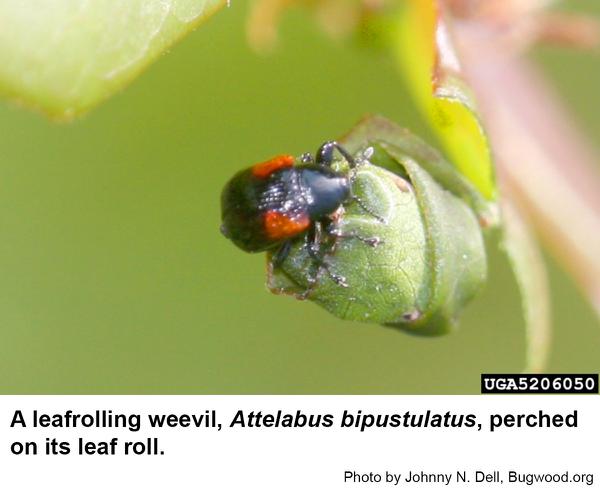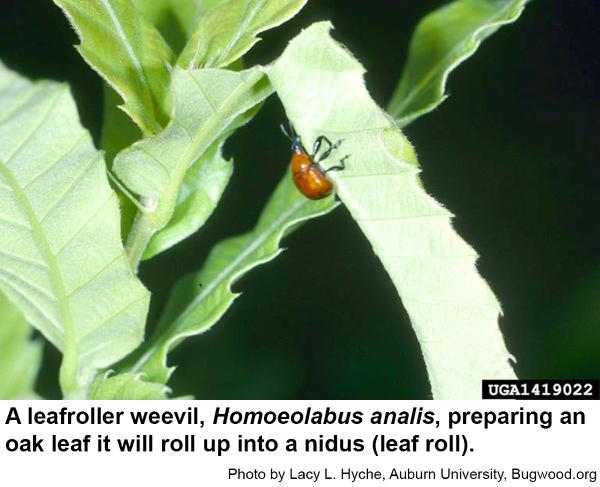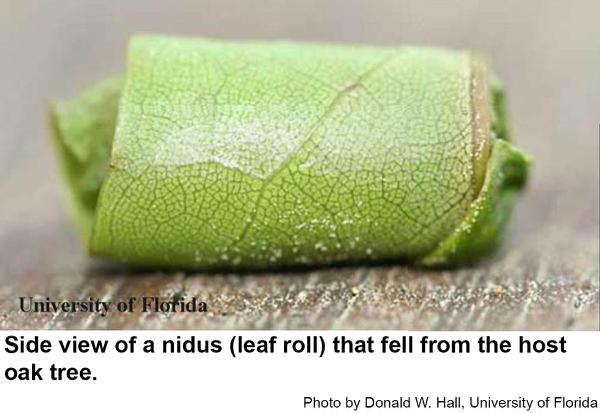Description and Biology
Attelabus bipustulatus is a small, shiny, chunky, black weevil with two bright red spots, one on each wing cover. A very similar insect, the oak roller weevil, Homoeolabus analis, is also small, shiny, and chunky, but is burnt orange except for its black head and legs. These weevils are less than ¼ inch long. The egg is tiny and shaped like a rugby football. Leafrolling weevil grubs are legless, curved, plump insects with brown heads. These leafrolling weevils provide for their offspring in a remarkable way: First the weevils chew slits on either side of the midrib. Then the egg is laid near the tip. The leaf is then folded along the midrib and then rolled into a neat leaf bedroll (the nidus) with the egg near the center. The grub hatches and feeds on the leaf tissue inside the cylinder and eventually pupates inside the roll. Sometime later a new generation of leafrolling weevils emerges to complete their life cycle. There may be more than one generation per year.
Host Plants
Leafrolling weevils have been observed on 16 species of oaks and two species of chestnut.
Residential Recommendations
These weevils are seldom abundant enough to be considered pests. Confining some of the leaf rolls in a jar inside the house will allow the witnessing of the miracle of the wheel of existence for these tiny, attractive insects. If the weevils have gotten way out of hand, they should be susceptible to pyrethroid insecticide labeled for home landscape use. When used as directed, pyrethroids are very toxic to insects but are not particularly hazardous to humans and pets (other than fish-avoid using pyrethroids around pools, ponds, and streams). Treating early in the season should protect trees for most of the growing season, although it seems a shame to kill such attractive and interesting insects.
References
- Kaufman Field Guide to Insects of North America. Eaton, E. R. and K. Kaufman. 2007. Hillstar Editions, LC, Tucson, Arizona. 221 pp.
- Leaf-Rolling Weevil, Homoeolabus analis (Illiger) (Coleoptera: Attelabidae: Attelabinae) and Thief Weevil, Pterocolus ovatus Fabricius (Coleoptera: Rhynchitidae: Pterocolinae). Hall, D. W. and L. J. Buss. 2015. EDIS, University of Florida IFAS Extension. Publication #EENY-420.
- Extension Plant Pathology Publications and Factsheets
- Horticultural Science Publications
- North Carolina Agricultural Chemicals Manual
For assistance with a specific problem, contact your local Cooperative Extension Center.
This Factsheet has not been peer reviewed.
Publication date: March 17, 2017
Revised: Dec. 22, 2021
Recommendations for the use of agricultural chemicals are included in this publication as a convenience to the reader. The use of brand names and any mention or listing of commercial products or services in this publication does not imply endorsement by NC State University or N.C. A&T State University nor discrimination against similar products or services not mentioned. Individuals who use agricultural chemicals are responsible for ensuring that the intended use complies with current regulations and conforms to the product label. Be sure to obtain current information about usage regulations and examine a current product label before applying any chemical. For assistance, contact your local N.C. Cooperative Extension county center.
N.C. Cooperative Extension prohibits discrimination and harassment regardless of age, color, disability, family and marital status, gender identity, national origin, political beliefs, race, religion, sex (including pregnancy), sexual orientation and veteran status.





